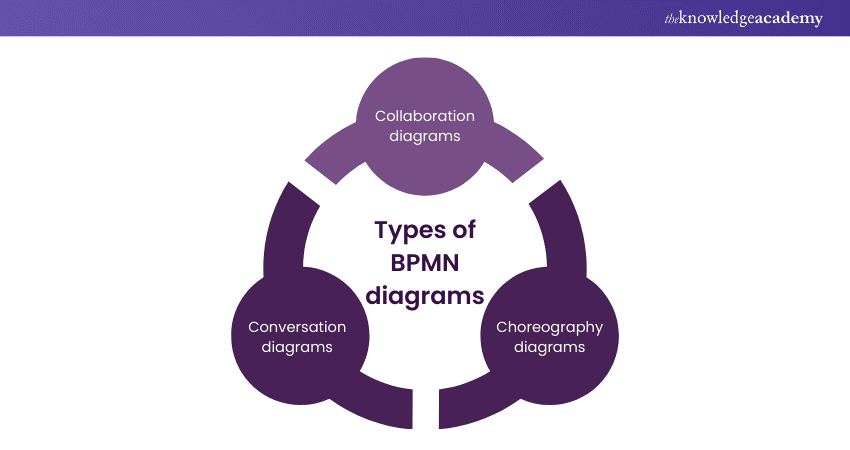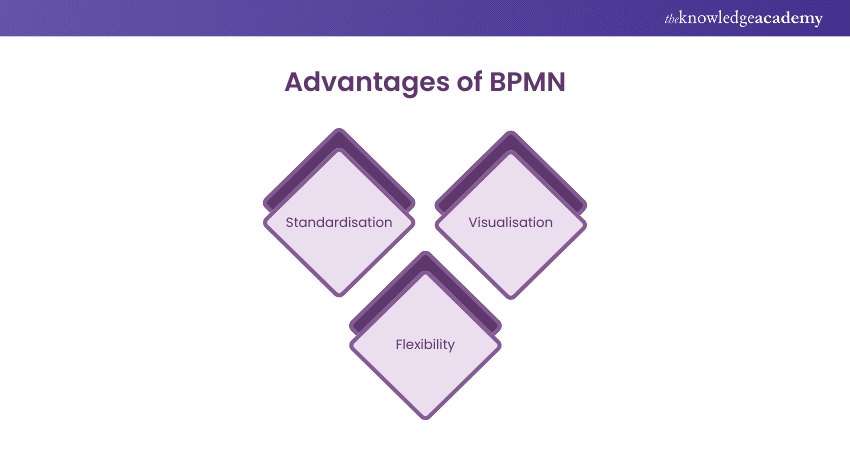We may not have the course you’re looking for. If you enquire or give us a call on +357 26030221 and speak to our training experts, we may still be able to help with your training requirements.
We ensure quality, budget-alignment, and timely delivery by our expert instructors.

From understanding the basics of BPMN to mastering its intricacies, we'll guide you through the process step by step. Our goal is to provide you with the information and abilities required for optimal use of this powerful tool.
Prepare yourself for an adventure of exploration! In this blog, we'll explore various aspects of BPMN, including its different diagram types, goals, advantages, and practical tips for mastery. Let's dive in and discover the transformative capabilities of BPMN together!
Table of Contents
1) What is Business Process Modelling Notation (BPMN)?
2) History of BPMN
3) How does Business Process Modelling Notation (BPMN) work?
4) Different types of BPMN diagrams
5) The goal of BPMN
6) Advantages of BPMN
7) Tips for Business Process Modelling Notation (BPMN)
8) Example of BPMN
9) Conclusion
What is Business Process Modelling Notation (BPMN)?
Business Process Modelling Notation is a standardised graphical language utilised to visually depict business processes. It acts as a comprehensive framework for stakeholders for evaluation of business processes. Standardised symbols and notations are employed. This in turn enhances good communication and collaboration between stakeholders across domains and organisation hierarchies.
This is where BPMN contributes as a powerful tool which refines process management, analysis, and optimisation in the organisation. It provides a standardised framework thus contributing to the business’ efficiency and effectiveness.
History of BPMN
BPMN was first developed in 2004 by the Business Process Management Initiative (BPMI) and the Object Management Group (OMG) later adopted in 2005. Since then, it has become the de facto standard for business process modelling.
Take your career to the next level with the BCS Foundation Certificate in Business Analysis!
How does Business Process Modelling Notation (BPMN) work?
Business Process Modelling Notation functions through the utilisation of standardised symbols and notation, each representing distinct elements within a business process. These elements encompass activities, events, gateways, and flows, among others. By arranging these symbols within diagrams, BPMN illustrates the sequential flow of activities and information within a process.
This visual representation allows stakeholders to comprehend the intricacies of the process. They can use it to identify any inefficiencies or bottlenecks and develop optimisation and improvement plans.
Enhance your skills in Business Analysis with the BCS Practitioner Certificate in Modelling Business Processes!
Different types of BPMN diagrams
Here are the different types of BPMN diagrams:

1) Collaboration diagrams
Collaboration diagrams in BPMN illustrate interactions between participants involved in a business process in business process modelling. They provide a visual representation of how various entities collaborate and communicate with each other to accomplish a shared objective.
These diagrams typically depict the exchange of information, tasks, or resources between different participants. They help stakeholders understand the roles and relationships among participants in the process. By visualising these interactions, collaboration diagrams facilitate communication, coordination, and alignment among stakeholders involved in the business process.
2) Choreography diagrams
Choreography diagrams in BPMN outline the sequence of interactions between participants within a process in business process modelling. Unlike other diagrams, they don't detail the internal behaviour of each participant. Instead, they emphasise the overall flow of activities and messages exchanged among participants. This offers a holistic view of how different entities interact to accomplish a common goal.
Choreography diagrams illustrate communication patterns and coordination among participants, focusing on overall interactions rather than individual entity internals. These diagrams serve as a valuable tool for visualising complex interactions and ensuring alignment among stakeholders involved in the process. They promote clarity and collaboration in achieving organisational objectives.
3) Conversation diagrams
Conversation diagrams in BPMN provide a high-level overview of interactions and messages exchanged among participants within a process in business process modelling. Unlike choreography diagrams, which focus on the sequence of interactions, conversation diagrams offer a more abstract view.
They depict the overarching communication patterns between participants without delving into the specifics of individual interactions. These diagrams help stakeholders understand the flow of communication and coordination at a broader level, facilitating alignment and collaboration across the organisation.
Master Business Analysis essentials and elevate your career with a BCS Certificate in Business Analysis Practice!
The goal of BPMN
BPMN aims to standardise and simplify business process modelling and communication across stakeholders for improved collaboration and efficiency. By offering a common language and notation system, BPMN enhances comprehension, collaboration, and efficiency in managing and optimising processes.
Its standardised framework ensures consistent interpretation across teams, facilitating seamless communication and alignment of objectives. This leads to enhanced organisational effectiveness and performance.
Achieve excellence with the BCS International Diploma in Business Analysis!
Advantages of BPMN
The following are the advantages of BPMN:

1) Standardisation
BPMN offers standardised notation, ensuring consistency and clarity in Business process modelling. This uniformity facilitates seamless communication and collaboration among stakeholders, streamlining decision-making processes and promoting alignment across departments.
With a shared language for depicting business processes, organisations can more effectively convey complex workflows, identify inefficiencies, and implement improvements. Finally, BPMN's standardisation fosters greater transparency and understanding, enabling teams collaborate effectively to achieve common objectives and promote corporate success.
2) Visualisation
In Business Process Modelling, BPMN provides a visual representation of business processes, enhancing understanding and analysis. By depicting processes graphically, stakeholders can easily identify inefficiencies, bottlenecks, and improvement opportunities. This visualisation aids in clarifying complex processes, enabling more informed decision-making and strategic planning.
With BPMN diagrams, organisations gain insights into the flow of activities, allowing for targeted optimisations and streamlined operations. Overall, visualisation through BPMN promotes transparency, collaboration, and continuous improvement in business process management.
3) Flexibility
In Business Process Modelling, BPMN offers flexibility by accommodating processes of diverse complexities and scopes. Its adaptable nature allows organisations to scale their modelling efforts seamlessly. Whether representing simple workflows or intricate systems, BPMN provides a standardised framework for visualising and analysing processes.
This flexibility enables businesses to tailor their models to specific needs, ensuring they accurately capture the intricacies of their operations. Consequently, organisations can effectively communicate, analyse, and optimise processes, driving efficiency and agility across their operations.
Master Digital Product Management with the BCS Practitioner Certificate in Digital Product Management Training!
Tips for Business Process Modelling Notation
1) Start with the end in mind: Define the objectives and scope of your BPMN model before starting the modelling process. Clearly identify the desired outcomes and stakeholders involved to ensure the model meets their needs.
2) Use standard notation: Follow BPMN standards and conventions when creating your models to ensure consistency and compatibility with other BPMN diagrams. Use standard symbols and notation to represent different elements of the process.
3) Keep it simple: Avoid unnecessary complexity in your BPMN diagrams by focusing on the most important aspects of the process. Use clear and concise language to describe activities, events, and flows to avoid confusion.
Example of BPMN
To illustrate BPMN in action, let's consider a simplified example of an order processing system. The BPMN diagram would include symbols representing activities such as "Receive Order," "Process Payment," and "Fulfil Order" and flows indicating the sequence of these activities.
Unlock Agile excellence with the BCS Foundation Certificate in Agile Training!
Conclusion
Business Process Modelling Notation is a powerful tool for representing and analysing business processes in a standardised and visual manner. By using BPMN, organisations can improve understanding, communication, and efficiency in managing and optimising their processes.
Excel in Planning and Realisation with the BCS Professional Certificate in Benefits Planning and Realisation Training!
Frequently Asked Questions

The most used notations in process modelling include Business Process Model and Notation (BPMN), Unified Modelling Language (UML), and Event-driven Process Chain (EPC).

The four fundamental symbols used in a Business Process Model Notation are flow objects, connecting objects, swim lanes and artefacts.

The Knowledge Academy takes global learning to new heights, offering over 30,000 online courses across 490+ locations in 220 countries. This expansive reach ensures accessibility and convenience for learners worldwide.
Alongside our diverse Online Course Catalogue, encompassing 17 major categories, we go the extra mile by providing a plethora of free educational Online Resources like News updates, Blogs, videos, webinars, and interview questions. Tailoring learning experiences further, professionals can maximise value with customisable Course Bundles of TKA.

The Knowledge Academy’s Knowledge Pass, a prepaid voucher, adds another layer of flexibility, allowing course bookings over a 12-month period. Join us on a journey where education knows no bounds.

The Knowledge Academy offers various blogs on Business Analysis, including BCS Practitioner Certificate In Modelling Business Processes Training, BCS Foundation Certificate In Organisational Behaviour, BCS Practitioner Certificate In Requirements Engineering and more. These courses cater to different skill levels, providing comprehensive insights into Strategic Business Management.
Our Business Analysis Blogs cover a range of topics related to Business Analysis, offering valuable resources, best practices, and industry insights. Whether you are a beginner or looking to advance your Analysis skills, The Knowledge Academy's diverse courses and informative blogs have you covered.
Upcoming Business Analysis Resources Batches & Dates
Date
 BCS Practitioner Certificate in Modelling Business Processes Training
BCS Practitioner Certificate in Modelling Business Processes Training







 Top Rated Course
Top Rated Course



 If you wish to make any changes to your course, please
If you wish to make any changes to your course, please


